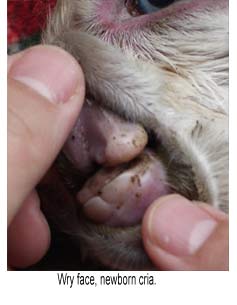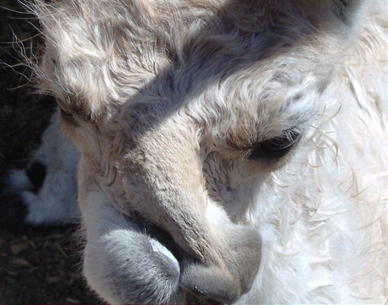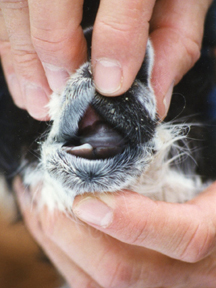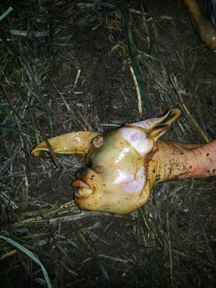I always like to start out an article of this type with a few
definitions, some of which may be totally inappropriate but all of which are
intended to help the reader hang in there to read the entire article.
For this reason, I'm inclined to first discuss the
misconception that wry face is rye face. There's rye the cereal grain,
from which we get rye bread and rye whiskey, and of course there's
Catcher in the Rye by J. D. Salinger. Only with tongue in cheek is rye
face closely related to wry face: after one drinks a swig of rye
whiskey, he or she will likely make a wry face.
For the purposes of this article, the more
appropriate use of the term wry is in reference to a crooked neck--hence
the condition's common name wry neck; its medical name is torticollis.
As a verb, wry literally means "pull out of proper shape, make awry"; as
an adjective, it means "having a bent or twisted shape or condition,
turned abnormally to one side," and "wrongheaded." When applied to
the face, it means an altered facial conformation. Theoretically, the
principal facial bones that would be involved in wry face are the
mandible (lower jaw) and the maxilla (upper jaw), separately or in
combination. In reality, the problem, as I've observed it in both llamas
and alpacas, has markedly involved the maxilla and only subtly the
mandible.
While the numbers of observed
and reported cases in North America to date favor the llama, there are
increasing cases in alpacas as their populations increase.
On occasion I've been asked to render an opinion on a newborn camelid that
"appears to have a crooked nose." Fortunately, in most of these instances,
I've been convinced that there is a suggestion of a crooked nose only
because of either a whorl (cowlick) of hair or a pigment design
change, and that the nose is really normal. To date, wry face individuals
have been quite grossly affected at birth and can be readily
diagnosed; however, I would be the first to admit there could be some
minimally affected cases out there.
Wryface is most easily recognized by the lack of proper dental
occlusion.
Photos of Wryface in llamas and alpacas. |

|
 |

|
 |
We have had some wry face individuals presented or donated to the
Veterinary Teaching Hospital at Colorado State University (CSU) in late
juvenile as well as adult ages. What has really impressed me about these and
other cases is that the animals somehow are able to learn to nurse and
fend for themselves at the feed bunk quite effectively. This is all the more
amazing because the molars and premolars of the affected animal's two jaws
lack proper dental occlusion and the mandibular incisors make virtually no contact with the
maxillary dental pad. No doubt in a true browsing/grazing situation,
affected individuals would have a tough time surviving.
Another fairly consistent problem of affected individuals is a compromise
of the normal drainage duct (nasolacrimal duct) from the eye to the
nose, causing a constant tear staining. The cause appears to be
compression of the duct and the result is partial or full obstruction. The
combination of poor dental occlusion and the tendency toward chronic
tearing and eye afflictions often causes affected surviving individuals to
be "poor doers"; hence they are generally euthanized because of their poor
prognosis for a quality life.
Now, do I know
that wry face is a genetic problem? No, I'll have to admit that I don't
know that any abnormality seen to date is absolutely for sure genetic in
origin. I will note that our now-departed colleague, Dr. Horst Leipold
(regarded in most circles as the guru of genetic and congenital defects),
was outspokenly confident that most facial defects of camelids (choanal
atresia, wry face, cleft palate) are very likely genetic in origin. As an
example from my own experience, I'll cite a female llama, Prima, that was
bred to the same male for three consecutive years and delivered two
consecutive wry face crias and then a "normal" one. After Prima was
donated to CSU, it was bred to several studs and subsequently has
never produced another affected individual in the resultant five
offspring.
I have previously expressed
an opinion that wry face and choanal atresia have some relationship. I was
somewhat qualifiedly pleased that a female llama with a track record of
two consecutive choanal atresia babies produced a third choanal atresia
cria in a mating with a wry-faced male. Subsequently the same mating has
produced what appears to be a perfectly "normal" female cria that is both
woolly and appaloosa, traits that neither parent possesses phenotypically.
Isn't genetics wonderful?
Prima and three
daughters that could be carriers of the wry face trait currently reside at
CSU. In addition, two gelding sons that guard sheep are in the area. We
have been breeding all the CSU female herd to "DH," our resident wry face
stud. To date, with five crias born, none appears to be clinically
affected. Perhaps this year?
Unfortunately,
Prima is now infertile and the current herd does not include any wry face
individuals or phenotypically normal females with a track record of
producing wry face crias. I have been accumulating and freezing blood and
tissue samples from affected llama and alpaca crias that I have been made
aware of as well as from their parents.
At this point, I'm assuming that the problem
is genetic in origin and likely involves both parents. If it indeed is
genetic, the mode of inheritance is not clear. I'd be surprised if it were
simply Mendelian recessive in nature. More likely, multiple alleles are
influencing the occurrence with possible incomplete penetrance. If that is
the case, suffice it to say that the mode of inheritance is complicated.
Simple breeding trials such as those I am currently performing will not
readily assist in determining the mode of inheritance; nor will they
practically assist in determining the presumed carrier status of
incriminated parents. What's really needed is cooperative research in the
areas of chromosome analysis, gene mapping, and perhaps DNA
fingerprinting. These technologies and associated research are not
something we are currently engaged in at CSU. My hope is that individuals
currently involved in these areas will be inclined to put forth a
cooperative effort with us, using the CSU herd, likely the most
concentrated group of animals with the wry face problem, and our samples.
In the alpaca world, the emerging history of
wry face and other facial defects, including choanal atresia, cleft
palate, and cyclopia, appears comparable to that of the llama. You as
alpaca breeders are perhaps wondering why I don't have an alpaca herd to
do research on, and perhaps it doesn't seem logical to draw inferences
from llamas to alpacas. If I may be allowed to opine at this juncture,
given time an affected alpaca herd will likely be available. It took a
while for llama owners to realize that wry face is a real problem and that
the reduction of presumed carrier animals in their herds and the
population in general is beneficial. No doubt the gradual reduction of
llama prices contributed to the donation of animals for research or at
least their culling. Considering the common ancestral origin of these
domesticated camelids and contemporary similarities of anatomy and
physiology, one is logically inclined to extrapolate information from one
species to the next. Furthermore, considering the limited research dollars
available, to feel that all research efforts must be carried out in the
camelid species of your interest in order to be meaningful could be
characterized as tunnel
vision.
In summary, wry face does have a
significant but as yet undocumented occurrence in both domesticated
camelid species. I would hope that you, like me, are convinced that the
wry face condition is a serious problem in camelids, and furthermore, that
research using advanced genetic techniques is the next step in
understanding the condition. I would challenge you as responsible breeders
to carefully consider the occurrence of all facial defects, including,
especially, choanal atresia and wry face, to likely be genetic in origin
until proven otherwise. There are surgeons who could "correct/improve" the
physical appearance of affected animals; however, such individuals should
never be falsely represented at shows or sold without revealing their
altered history; nor, in my opinion, should they be used for breeding
purposes.
About the Author
LaRue W. Johnson is full professor and section chief
of Food Animal Medicine and Surgery, College of Veterinary Medicine, Colorado
State University, where he has taught since 1976. He has worked with llamas for
fifteen-plus years and alpacas for the past five. Dr. Johnson has been a speaker
at most veterinary and camelid organizations and is current president of the
American Association of Small Ruminant Practitioners. He has edited two editions
of Veterinary Clinics of North America--Llama Medicine. He received his BS, DVM,
and PhD from the University of Minnesota.
|
Photos of Wry Face in a
Llama Cria
|
|

Notice the lower jaw is not in
alignment with the upper jaw.
|

Teeth are erupted in the lower jaw
(mandible) but the entire lower jaw
is not
in alignment to the maxilla (upper jaw).
|

The lower jaw is shifted to the left.
It is not centered with the
upper jaw. |
| |

Wry Face along with other birth defects.
|
|